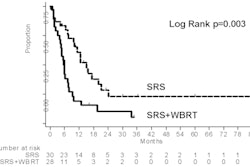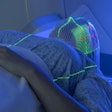Preliminary study results suggest that stereotactic body radiation therapy (SBRT) provides good prostate-specific antigen (PSA) response for early-stage prostate cancer, with side effects comparable to those of conventional radiation therapy treatment.
The outcomes of 41 patients after a median 33 months of follow-up in a prospective phase II trial are reported by researchers from Stanford University School of Medicine in Stanford, CA, in the March 15, 2009, issue of the International Journal of Radiation Oncology, Biology, Physics (Vol. 73:4, pp. 1043-1048).
The clinical trial of hypofractionated SBRT was initiated in December 2003 for low-risk prostate cancer patients with the objective of identifying patterns of PSA response, early and late urinary and rectal toxicities, and quality of life measures. The criteria defining "low risk" were a prebiopsy PSA of 10 ng/mL or less, a biopsy Gleason grade of 3 + 3 or lower, and a clinical stage T1c or T2a/b as defined by the American Joint Committee on Cancer in 2002. None of the patients had received any kind of prior treatment.
Patients ranged in age from 48 to 83 years, with a median age of 66. After three fiducial markers were placed in the prostate via transrectal ultrasound guidance and patients underwent a CT scan, anatomic contouring of the prostate, seminal vesicles, rectum, bladder, penile bulb, and femoral heads was performed.
Dose was prescribed to a planning target volume consisting of a volumetric expansion to the prostate by 5 mm, reduced to 3 mm in the posterior direction. The optimal treatment program respected rectal tolerance, a very important consideration when delivering hypofractionated radiotherapy, according to lead author Dr. Christopher King, an associate professor of radiation oncology.
For the first 21 patients, SBRT (CyberKnife, Accuray, Sunnyvale, CA) was given in five fractions of 7.25 Gy over five consecutive days. Because the first 21 patients were experiencing a level of rectal toxicity that disappointed the researchers, treatment for all subsequent patients was modified to three times each week until a total dose of 36.25 Gy had been received.
All patients in this ongoing trial are followed up every three months. The 41 patients whose outcomes are reported represent a follow-up range of six to 45 months.
Toxicity and quality of life
Urinary and rectal toxicities were comparable to toxicities experienced by patients who received conventionally fractionated courses of external-beam radiation therapy.
Two patients experienced grade 3 urinary toxicity. The authors reported that after an initial deterioration in the first three months, most patients returned to near-baseline levels of urinary satisfaction, and many improved above baseline levels after one or two years following treatment. Whether a patient had daily treatment or treatment every other day did not affect toxicity.
At the commencement of treatment, 89% of patients reported no rectal problems, and 11% reported very small to small problems. Rectal quality of life became worse at three months, with only 37% reporting no problems, 48% reporting very small to small problems, and 16% reporting moderate problems. At the one- and two-year follow-up, 46% and 45% of the patients, respectively, had no problems. However, 50% reported very small to small problems at one year, and 4% had moderate problems.
The percentage of the group with problems remained unchanged at year two, except that 5% had their problems worsen to a moderate level. None of the patients experienced grade 3 or 4 rectal toxicities. Patients who did not have daily treatment had less severe rectal toxicity.
PSA response
The pattern of PSA response is highly encouraging, according to King. Of the 32 patients with one year or more of follow-up, 25 achieved a PSA nadir of 0.4 ng/mL. Twelve patients had a benign PSA bounce between 12 and 33 months after radiation therapy, with a mean bounce height of 0.39 ng/mL. The PSA bounce is comparable to external-beam radiation therapy or permanent brachytherapy with respect to the timing, magnitude, and level of frequency that has been previously reported, according to the authors.
The clinical trial is continuing. The authors emphasize that longer follow-up is necessary to confirm durable biochemical control rates and low late-toxicity profiles.
By Cynthia E. Keen
AuntMinnie.com staff writer
April 9, 2008
Related Reading
NY Times: CyberKnife Medicare coverage varies in U.S., December 23, 2008
VMAT provides same treatment as IMRT in half the time, October 31, 2008
Copyright © 2009 AuntMinnie.com



















